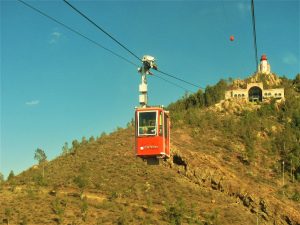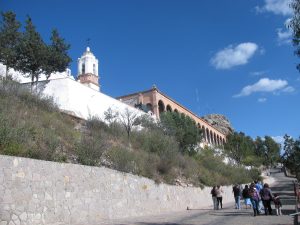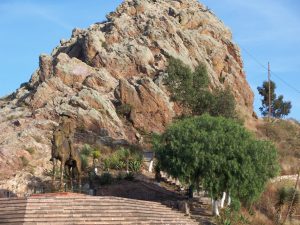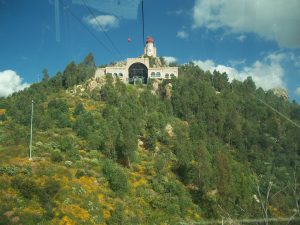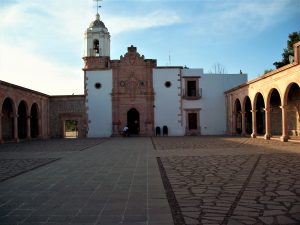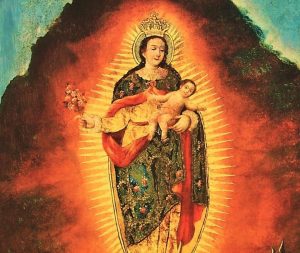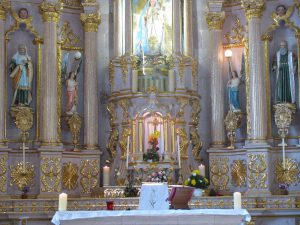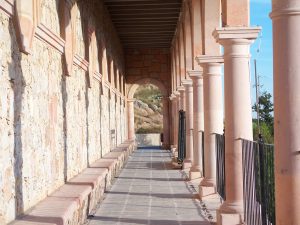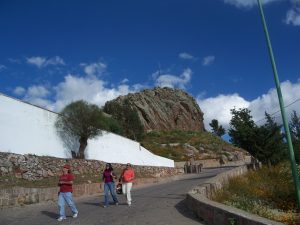Monthly Archives: August 2023
OUR LADY OF PATROCINIO, Zacatecas, Zac.

Zacatecas. It’s one of those places that travel writers rave about. A mountainous city in north central Mexico, it’s a place of superlatives. Considered one of the finest of Mexico’s colonial cities it was once the largest silver-producing city in the world and for three centuries was one of the country’s most prosperous areas. And that’s not all: It is renowned for having the only cable-car system in the world to traverse an entire city. It is no wonder that it was designated a UNESCO World Heritage site in 1993.
And that cable-car leads directly to the shrine of LA VIRGEN DEL PATROCINIO, majestically situated atop the Cerro de la Bufa (Hill of the Bufa). The Bufa is a dramatic outropping of rock which overlooks the city. With its altitude of 2,267 metres, it is a strategic landmark for miles around.
This shrine is closely tied to the history of Zacatecas. The statue of Our Lady of Patrocinio was brought from Spain by the Spanish conquistador, D. Diego de Ibarra. It was recorded as being present in 1546 at the founding of the city by Juan de Tolosa and three other conquistadores.
In 1588 Spanish King Felipe ll ordered a coat of arms for the city. Prominent on the shield was an image of the Virgin Mary standing on clouds atop the hill of the Bufa, between the moon and the sun. The four founding Spanish conquistadores are depicted at the foot of the hill.
And why would Our Lady be featured on such a shield? It was because she played a significant role in the city’s history. This role can be traced back to a tradition that is almost 500 years old: Initially the Chichema Indians of the region were terrified of the Spaniards. They took refuge in the Cerro de la Bufa, hiding in the woods at the encroachment of the invading foreigners, fortifying themselves with supplies and possible weapons. Then came the events of 1535!
During a “bloody battle” between the two factions, the parties were astounded by a vision in the sky—“A Lady of great beauty appeared on the Bufa with a child in her arms.” She advised the Indians to make peace with the Spaniards. All present were startled, indigenous and Spaniards alike, and shouted, “Milagro! Milagro!” (miracle). From that time on peace ensued between the two groups and the conversion of the Chichema to Christianity proceeded rapidly.
The Zacatecans have received many favours from their Patrona (she is the Patron of the city) throughout the centuries. She is known for her powers of healing. On many occasions, in times of epidemics, drought, calamity, natural disasters and revolution, she was led in procession from her hilltop mount to the Cathedral of Zacatecas.
The statue is made of cedar wood and measures 1.25 metres in height. It is enshrined above the main altar, flanked by graceful columns. Neoclassical architecture dominates the interior of the church. The small church has undergone several renovations in its lifetime with the present church being completed in 1795.
The image has received church approval at the highest levels. On September 23, 1796, Pope Pius Vl granted a plenary indulgence to all who would visit the shrine. The statue was crowned canonically with the authority of Pope Paul Vl in 1967. Cardinal Jose Garibi Rivera solemnly crowned the statue of El Patrocinio in the presence of 15,000 of the faithful.
“Zacatecas has always been the city of Mary,” he said, “right from the beginning.”
One more point about Zacatecas, that city of superlatives: It is most likely the only church in the western hemisphere that can be reached by cable car. And the views from the shrine? They are superb, panoramic—and without a doubt, heavenly!
THIS ARTICLE IS REPRINTED WITH PERMISSION FROM The Catholic Register.
IMPORTANT NOTICE!!!
THE NAME OF THIS WEBSITE HAS BEEN CHANGED TO:
mexicanmadonnas.com
